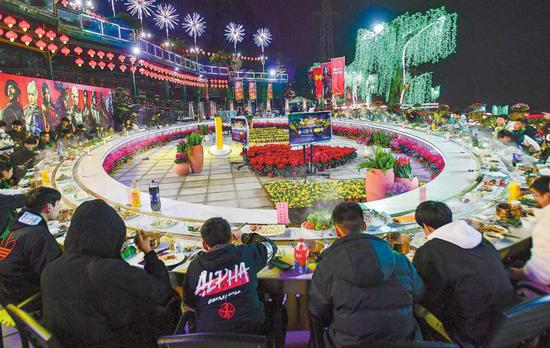
Consumers dine at a Loquat Garden hotpot restaurant in Southwest China's Chongqing in February. (CUI JINGYIN/FOR CHINA DAILY)
If you walk along stunning mountain trails, taking in deep breaths of fresh air, but are not exactly on a vacation, then chances are that you are heading to the world's largest hotpot (huo guo) restaurant.
Located in Nan'an district in Southwest China's Chongqing municipality, Loquat Garden is welcoming a surging number of customers, not only Chinese but also foreign visitors, this summer.
Unlike traditional ones, the hotpot restaurant is mostly open-air and terraced on a large hill. Visitors can enjoy its delectable cuisine while sitting amid loquat trees that give out a delightful fragrance.
When the loquats ripen, visitors can pick and taste them for free, making it a natural fine dining experience.
Since its establishment in 2003, Loquat Garden has improved customer services and expanded in size.
It was officially recognized as the "world's largest hotpot restaurant "by Guinness World Records in July 2022.
Covering an area of 80 mu (5.33 hectares), Loquat Garden is equipped with about 800 tables that can accommodate more than 6,000 diners simultaneously.
However, if you want to dine here during the peak tourist season, reservations will be needed three to five days in advance.
Gan Yuanchuang, one of the managers of Loquat Garden, said the restaurant is popular not only for its huge size, but also for its high-quality food.
Gan said the vegetables are provided by nearby farmers and the meat products are purchased directly from slaughterhouses so as to ensure freshness.
Benefiting from this sound business strategy, Loquat Garden has so far opened three directly operated outlets in Chongqing and quite a few franchise stores across the country, especially in Northeast China, Gan added.
A netizen surnamed Yang told China Daily that she visited Loquat Garden along with her family during a recent trip to Chongqing.
"I was deeply impressed by its size. I think it could take more than 20 minutes to walk from the parking lot at the bottom of the hill to the highest table," she said.
Yang said the restaurant is decked with colorful lights, which make it more attractive at nighttime, and the famous scenic spots nearby provide tourists with multiple options for after-meal entertainment.
"As for shortcomings, I think it's the inconvenient transportation. You have to drive or take a taxi to get there. I really expect more improvements in this regard," she said.
Zhou Mi, a researcher at the Beijing-based Chinese Academy of International Trade and Economic Cooperation, said Loquat Garden has set a good example for hotpot restaurants amid intensifying competition.
"Loquat Garden sources most of its ingredients locally and has given full play to the natural scenery …That's what makes the restaurant more competitive than most of its peers," said Zhou.
According to Zhou, hotpot restaurants, especially those in rural areas, should seize the opportunities brought on by the rapid growth of China's rural tourism and better integrate local culture into their services, in order to provide customers with a more diversified experience.
This is also expected to promote healthy competition in the sector and contribute to the country's rural vitalization efforts, Zhou added.
Lin Shen, an associate research fellow at the Institute of World Economics and Politics of the Chinese Academy of Social Sciences, said Loquat Garden's business strategy conforms to China's requirements for promoting high-quality development of its catering and service industries.
Lin said good restaurants like Loquat Garden could unleash the consumption potential of China's catering sector, contribute to the inheritance of traditional Chinese culture, and advance the integrated development of primary, secondary and tertiary industries.
Besides, as rural restaurants continue to grow and create more jobs for local people, the problem of rural population drain will be moderately alleviated, Lin said.


















































 京公网安备 11010202009201号
京公网安备 11010202009201号